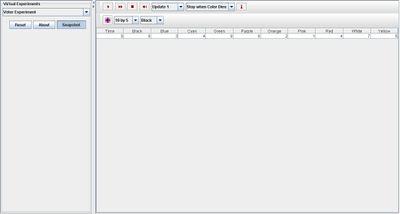SOCR EduMaterials Activities VoterExperiment
Voter Experiment
Description
Each site in the voter array can be in one of 10 states, represented by various colors. At each discrete time unit, a site is chosen at random, and then a neighbor of the site if chosen at random. The state (color) of the site is changed to the state (color) of the neighbor. The record table shows the number of sites of each color on each update. You can change the state of a site by selecting the desired color in the list box and then clicking on the desired site.
Goal
The Voter Experiment models the properties and characteristics of voter events. Users should be able to understand the basics of the Voter Experiment after using this simulation.
Experiment
Go to the SOCR Experiment [SOCR Experiment] and select the Voter Experiment from the drop-down list of experiments on the top left. The image below shows the initial view of this experiment:

When pressing the play button, one trial will be executed and recorded in the distribution table below. The fast forward button symbolizes the nth number of trials to be executed each time. The stop button ceases any activity and is helpful when the experimenter chooses “continuous,” indicating an infinite number of events. The fourth button will reset the entire experiment, deleting all previous information and data collected. The “update” scroll indicates nth number of trials (1, 10, 100, or 1000) performed when selecting the fast forward button and the “stop” scroll indicates the maximum number of trials in the experiment.
Note: the user may also execute the experiment until the state of the site is no longer applicable (stop when color dies).
For every run, at least one state changes the number of sites.
The experimenter has the abilities to change the probabilities in the selection box as well as the color and the range of sites in the list boxes. The image below demonstrates the basic function of the Voter Experiment:

Applications
The Voter Experiment is a simple application that can be used in many different types of situations such as:
Suppose statisticians want to demonstrate the affects of voting by using this simulation.
Translate this page: